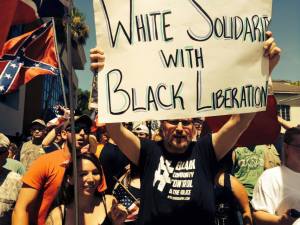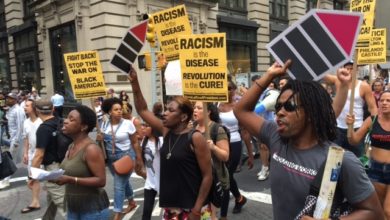On June 27, activists from the Tampa Bay area, including Uhuru Solidarity Movement, Party for Socialism and Liberation and others, held a
rally to express solidarity with the Black community and to stand against racist violence. The action was prompted by the recent AME Church massacre in Charleston, the subsequent burning of six Black churches in Southern states and the ongoing epidemic of racist police brutality.
Brooksville, the county seat of Hernando County, is a small town of around 20,000 people. Hernando County is known for its history of vicious racism, having had the highest number of lynchings per capita of any county in the nation between 1900 and 1931. White supremacy remains active there today. In 2004, neo-Nazi group National Alliance leafleted door to door in the Spring Hill area. In 2010, Brooksville was the site of an anti-immigration rally organized by the neo-Nazi group National Socialist Movement.
When activists reached the Hernando County Courthouse, around two hundred people waving Confederate flags encircled the group. For 45 minutes, activists stood strong, chanting “White violence must go! White solidarity with the Black community!” In response, counter-protesters chanted “USA! USA” and attempted to provoke activists with repeated physical assaults, while police merely watched. Despite provocations, the anti-racist activists remained peaceful. Eventually, they were able to garner the support of people in the area. One person supplied them with water, while others stopped their cars to hear more of their message.
One of the rally’s main organizers, Bettejo Indelicato, told Liberation what motivated her to call the action.
“I wanted to help organize this rally in Brooksville because this town, which is part of my home, has a long history of systemic racism,” said Indelicato. “I wanted others to bear witness to the racism that is inherent in small Southern towns like Brooksville. As I said, it’s a silent racism. It’s normalized to the extent that even the people who uphold a racist mentality don’t recognize it. But having a rally here took away that shield of silence. Breaking that shield of silence gives us an opportunity to begin a dialogue.”
Liberation also spoke to Jesse Nevel of the Uhuru Solidarity Movement about the purpose of the action.
“We protested to express our solidarity with the African community in their struggle for liberation and to oppose white colonial violence such as the Charleston massacre and daily police murders,” said Nevel. “We believe that white society owes reparations to the Black community for our legacy of oppressing, enslaving and terrorizing them. Brooksville is no different from the rest of this country where white people lynched Black people for hundreds of years in addition to countless other forms of violence and terror we waged against the Black community. We wanted to expose that the white community is a divided community: On one side are those of us who stand for justice to African people. On the other side was a mob of white nationalists chanting ‘USA! USA!’ The line is drawn. We must pick a side.”
Celeste Crossman also spoke to Liberation about the importance of multinational solidarity, as well as the importance of the rally.
“Racism is not dead. In truth, it is still a very real problem,” said Crossman. “This truth has never felt more concrete to me than it did as we
stood together, 20 people united in solidarity with the Black community, engulfed in a sea of 300 screaming white nationalists. As they hung their Confederate flags over our faces, shouted vile slurs, and made it clear that they were armed, a number of them asked the same question: ‘Where are the Black members of your group?’ Standing in solidarity with the Black community meant being able to address these hostile people without putting members of the Black community at risk of harm. It is vital. However few our numbers were, standing up to this kind of hatred is important, if only to remind any outsiders who may be watching that these people are not only real, but numerous. The threat to our Black sisters and brothers is real. Overturning racist violence and creating a society in which these members of our community needn’t fear for their lives in all public spaces must begin with solidarity on the part of the privileged. White silence is truly white violence.”
Finally, Dayna Lazarus talked to Liberation about the unique nature of the action and why she believes it was an important contribution to the movement.
“Despite the fear that grew inside me as our event page became crowded with threats and hate, I decided to go. I remembered something that an African activist out of Portland once told me. He said that the most important thing that I can do as a white person is to talk to a skinhead, and change his mind, because that is something too dangerous for an activist of color to do. He said that some people, especially young people, who suffer from blind ignorance are just waiting for someone to open their eyes, and I agree with him, because I have seen it happen too. On Saturday I spoke to at least three counter-protestors and explained to them the true purpose of our protest. Not one person I spoke to knew the definition of institutional racism. Although I don’t know if my explanation got through, just as I don’t know if any of the messages of our protest got through to any of the counter-protesters, I believe we still planted a tiny seed by bringing that protest to their town. I doubt that they had ever seen anything like it, just as none of us had ever seen anything like it,” said Lazarus. “I hope that our protest started a conversation in Brooksville.”






